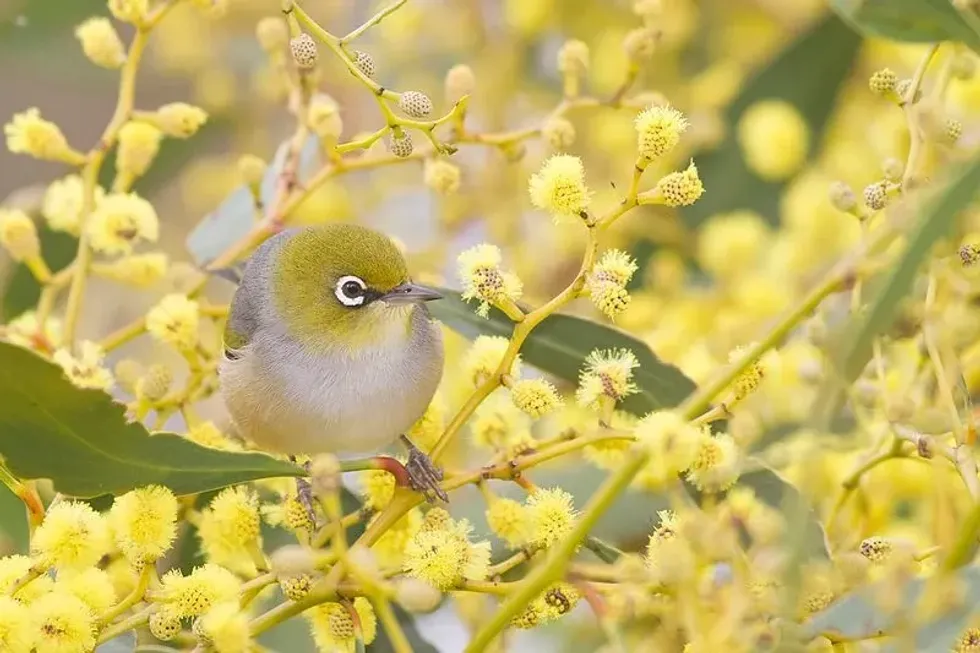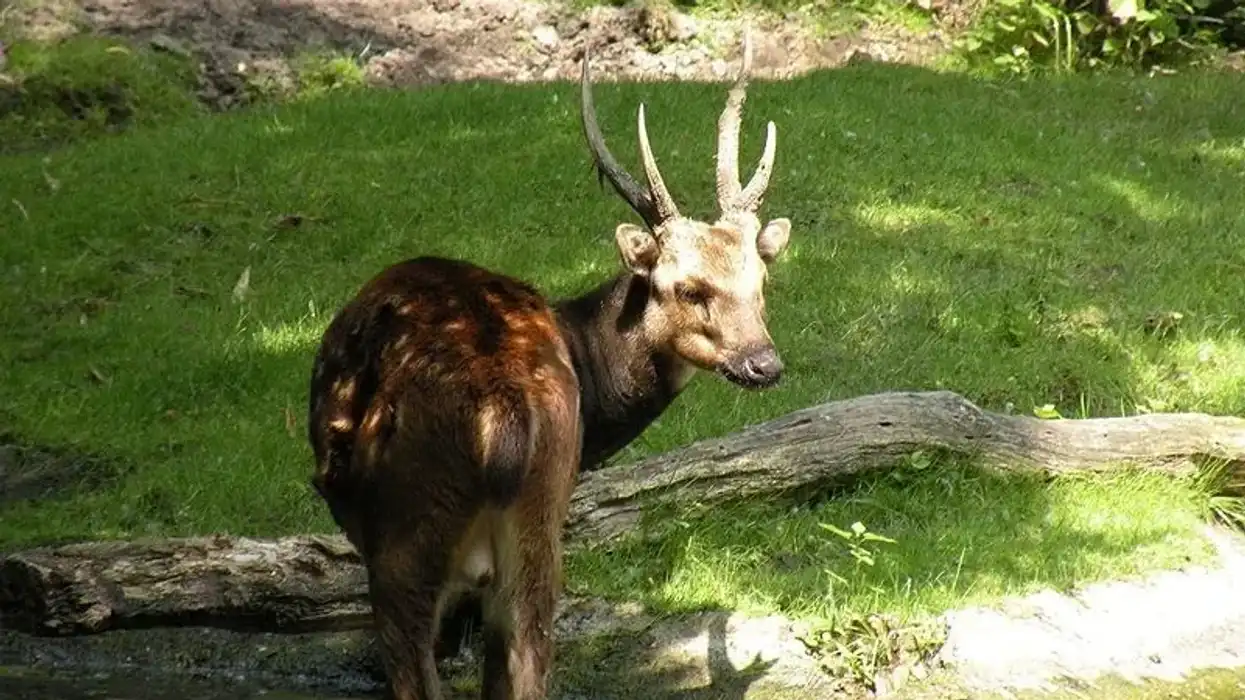The silvereye (Zosterops lateralis) is a passerine bird that belongs to the order Passeriformes and the family Zosteropidae. It is a small-sized bird that is native to New Zealand.
It is also commonly known as a wax-eye, a blight-bird, a waxeye, and a white-eye due to the ring of white feathers encircling its eyes. There are nine subspecies of the silvereye (Zosterops lateralis).
This bird is very friendly and has an olive-green coloration primarily. It has a tapering fine bill and a brush-tipped tongue that is similar to that of the bellbird and the tui. The underparts of this little bird are white-cream in color on its throat and cream-gray on its undertail and belly.
It also has pink-buff-colored flanks. The underside of each of its wings is whitish-cream in color.
The distribution of silvereyes is spread across New Zealand and Australia. They are resident birds on vegetated offshore islands and they fly seasonally islands like Little Barrier, Poor Knights, the Kapiti Islands, and the Three Kings.
These islands are homes to large populations of passerines like bellbirds too. Silvereye birds can be found across New Zealand in its outlying and offshore islands and in Australia.
They dwell in habitats like orchards, forests, woodlands, farmlands, urban areas, and suburban gardens.
The nest of this species is a cup woven out of fine vegetation, hair, and grasses. There is not a large number of these birds present in Otago's grassland areas, but these small-sized birds are widespread across their distribution and they are observed to form large flocks in the winter season.
These birds feed upon nectar, fruit, and insects. Keep reading to discover more fun facts about the breeding behavior, habitat, physical description, and more of silvereyes!
If you enjoyed reading our silvereye fun facts, you must check out our northern waterthrush surprising facts and common swift interesting facts too!
Silvereye Interesting Facts
What type of animal is a silvereye?
The silvereye (Zosterops lateralis) is a tiny passerine bird that was introduced in the 1800s in New Zealand and is now abundant throughout its range. It is a songbird that can be identified simply by the rings of white feathers encircling its eye. It has olive-green plumage with cream underparts. This bird has nine subspecies.
What class of animal does a silvereye belong to?
The silvereye bird belongs to the class of Aves.
How many silvereyes are there in the world?
The population of silvereyes has not yet been evaluated. As per the IUCN, their population trend is stable and they are present commonly across their distribution. Large flocks of silvereyes can be commonly spotted in the winter season in particular.
Where does a silvereye live?
These birds can be seen throughout New Zealand in orchards, farmlands, urban areas, and native scrublands and forests at altitudes up to 3937 ft (1200 m).
They are resident birds in Auckland, Snares, Kermadec, Stewart, Chatham, the Antipodes, and the Cambell islands. Even though these birds are resident on these offshore islands, they are known to seasonally fly to islands like Little Barrier, Poor Knights, the Kapiti Islands, and the Three Kings with other populations of passerines like bellbirds.
This bird can also be seen in coastal or sub-coastal Australia in heathlands, mangroves, shrublands, and rainforests.
What is a silvereye's habitat?
These birds build their nests in ferns, shrubs, and the outer branches of trees. Their nests are cup-shaped and are usually 26.2 ft (8 m) above the ground. These birds can be seen throughout many types of habitats that possess tree cover, but during winters, these birds aren't typically spotted in south-eastern regions of Australia.
Who do silvereyes live with?
This species is quite sociable and is known to form flocks comprising a large number of birds during winters. Silvereyes can be spotted in pairs, alone, or in flocks.
This species is quite mobile and looks for food actively in suburban gardens, scrublands, forests, and parklands. They also interact with each other within the flock, sometimes quite aggressively.
Within a flock, the dominant silvereye aggressively chases other birds and performs rapid flapping of its wings. Local movement according to the season and migration within the boundary of the country these birds live in may take place.
How long does a silvereye live?
These birds have a lifespan of 12 years!
How do they reproduce?
Silvereye birds are monogamous that form silvereye pairs for breeding. They exhibit territorial behavior during the nesting and breeding season.
Breeding starts in August and September, and the peak is between September and November. The nests of these birds can be found in tree ferns, shrubs, and the outer branches of trees.
Each nest is cup-shaped and it is well-constructed from fine twigs, spider web, hair, lichen, and moss. The male or the female can build the nest.
They may raise two to three clutches, with two to four eggs per clutch in a single breeding season. Silvereye eggs are pale blue in color and are incubated by both male and female birds.
Incubation takes 10-12 days after which the young chicks are born. They only possess two tiny tufts of down on their head when they are born and they open their eyes at the age of four days.
What is their conservation status?
The conservation status of this species is Least Concern according to the IUCN's Red List.
Silvereye Fun Facts
What do silvereyes look like?
This small bird can be identified easily by looking for its characteristic white eye-ring. The plumage of this bird is olive-green on its head, upper tail, and lower back, and gray on its upper back, neck sides, and hindneck.
Its upper wings possess narrow yellow-green colored lines and are mainly dark olive-green in color. The tail is also colored in a shade of dark olive green.
It has a white-cream-colored upper breast and throat, pink-buff flanks, white thighs, a creamy-gray undertail and belly, and creamy-white wing undersides.
They have a fine brown-black colored bill that is sharp and short and their feet and legs are both a shade of pale brown. Their chicks have a similar coloration, but they lack the eye-ring.
How cute are they?
These birds are quite charming creatures of New Zealand and Australia. The silvereye eye ring of white feathers is the characteristic feature of these native birds.
How do they communicate?
They produce a range of melodious calls that are quite high-pitched and comprise trills, warbles, and repeated sounds. Their flight call sounds like 'clii-cli'. The complete version of its song is a long warble that is quite soft. Its song is similar to that of the dunnock!
How big is a silvereye?
These birds range between 4.3-5.1 in (11-13 cm) in length. They are slightly smaller than the size of Kirtland's warbler.
How fast can a silvereye fly?
The speed of this species is not yet known due to a lack of research. However, we do know that this bird is very active and mobile. It is known to make local movements often and it makes sea crossings as well! They are known to migrate and can fly for long distances at the end of summer.
How much does a silvereye weigh?
Silvereye birds typically weigh 0.3 oz (10 g)!
What are their male and female names of the species?
Males are called 'cocks' and females are called 'hens', like all species of birds.
What would you call a baby silvereye?
A baby silvereye is called a chick!
What do they eat?
These birds are omnivores and they eat insects like flies, caterpillars, aphids, and spiders. They also eat small berries and fruit. Feeding upon lard and fat also occurs, primarily in winter. They prefer to feed upon the spreading flax-lilly fruit and beard heath berries.
These birds are also known to disperse seeds of native shrubs and trees. Silvereyes also support the pollination of seeds of tree species by simply feeding upon their nectar. Cats, stoats, and rats are known to prey upon these birds.
Are they dangerous?
Silvereyes are not dangerous birds. However, they flock to orchards and vineyards when their natural food sources are running short, where they can be a nuisance.
Would they make a good pet?
These small-sized birds have been observed to be quite friendly and but they are wild birds so they don't make great pets!
Did you know...
The Maori name of the silvereye is tauhou which translates to 'stranger' or 'new arrival'!
Silvereyes were observed in 1832 for the first time in New Zealand and they are classified as a native species here due to the fact that there is no proof of artificial introduction!
How do you attract silvereyes?
To attract these birds, silvereyes must have a clear and safe way to fly to your garden. There must be tall native trees present, or bushes and soft shrubs. Shrubs provide shelter and food for these birds. Silvereyes are attracted to native grasses mixed in with plants as they can forage for insects easily in them.
What's special about silvereyes?
The white-colored ring encircling each eye is what makes these birds stand out. They are renowned for these silvereye feathers which are their characteristic feature.
Here at Kidadl, we have carefully created lots of interesting family-friendly animal facts for everyone to discover! Learn more about some other birds from our common waxbill surprising facts and canyon towhee interesting facts.
You can even occupy yourself at home by coloring in one of our free printable bird coloring pages.










